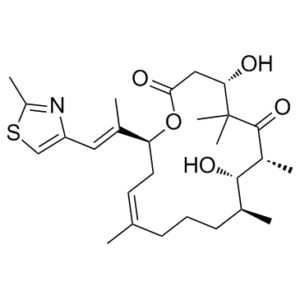Epothilone D (KOS 862)
This product is for research use only, not for human use. We do not sell to patients.

For small sizes, please check our retail website as below: www.invivochem.com
| Size | Price | Stock |
|---|---|---|
| 100mg | $1250 | Check With Us |
| 250mg | $2050 | Check With Us |
| 500mg | $3075 | Check With Us |
Cat #: V3524 CAS #: 189453-10-9 Purity ≥ 98%
Description: Epothilone D (formerly known as KOS 862; KOS-862; desoxyepothilone B) is a potent microtubule stabilizing agent that has high anticancer activity.
Top Publications Citing Invivochem Products
Publications Citing InvivoChem Products
Product Promise

- Physicochemical and Storage Information
- Protocol
- Related Biological Data
- Stock Solution Preparation
- Quality Control Documentation
| Molecular Weight (MW) | 491.68 |
|---|---|
| Molecular Formula | C27H41NO5S |
| CAS No. | 189453-10-9 |
| Storage | -20℃ for 3 years in powder formr |
| -80℃ for 2 years in solvent |
| Protocol | In Vitro | Epothilone D (KOS-862) is a more potent microtubule stabilizer in vitro than epothilone A or B. In vitro, Epothilone D has shown potent cytotoxicity in a panel of human tumor cell lines, with similar potency to paclitaxel. Epothilone D also shows a definite advantage over paclitaxel in drug-resistant cell lines, and retained its cytotoxicity against a multidrug resistant cell line over-expressing P-glycoprotein[1]. Epothilone D (EpoD) is a microtubules (MTs)-stabilizing agent |
|---|---|---|
| In Vivo | To evaluate whether Epothilone D (EpoD) improves MT and axonal function in PS19 mice, groups of 3-month old male PS19 mice received weekly i.p. injections of vehicle or Epothilone D (EpoD) (1 mg/kg or 3 mg/kg) for a total of 3 months. In addition, 3-month old non-Tg littermates received 3 mg/kg Epothilone D (EpoD) or vehicle. The 3 mg/kg Epothilone D (EpoD) dose corresponds to ~10-fold less than that used in a Phase II clinical study, which should minimize side-effects such as neutropenia that are observed with MT-stabilizing drugs in human subjects. PS19 and WT mice that receive Epothilone D (EpoD) show no signs of drug intolerance. Indeed, all drug-treated mice exhibited weight gain that is indistinguishable from vehicle-treated animals. Likewise, relative organ weights are similar in vehicle- and Epothilone D (EpoD)-treated mice. The motor performance of Epothilone D (EpoD)-treated mice, assessed using a standard rotarod test, is not significantly different from vehicle-treated cohorts. Finally, although there is minor group-to-group variability, there are no significant differences in white blood cell counts or neutrophil content between any of the treatment cohorts. Thus, the low doses of Epothilone D (EpoD) utilized in these studies appeared to be well tolerated |
These protocols are for reference only. InvivoChem does not
independently validate these methods.
| Solvent volume to be added | Mass (the weight of a compound) | |||
|---|---|---|---|---|
| Mother liquor concentration | 1mg | 5mg | 10mg | 20mg |
| 1mM | 2.0338 mL | 10.1692 mL | 20.3384 mL | 40.6769 mL |
| 5mM | 0.4068 mL | 2.0338 mL | 4.0677 mL | 8.1354 mL |
| 10mM | 0.2034 mL | 1.0169 mL | 2.0338 mL | 4.0677 mL |
| 20mM | 0.1017 mL | 0.5085 mL | 1.0169 mL | 2.0338 mL |
The molarity calculator equation
Mass(g) = Concentration(mol/L) × Volume(L) × Molecular Weight(g/mol)
Mass
=
Concentration
×
Volume
×
Molecular Weight*
The dilution calculator equation
Concentration(start)
×
Volume(start)
=
Concentration(final)
×
Volume(final)
This equation is commonly abbreviated as: C1 V1 = C2 V2
Concentration(start)
C1
×
Volume(start)
V1
=
Concentration(final)
C2
×
Volume(final)
V2
Step One: Enter information below
Dosage mg/kg
Average weight of animals g
Dosing volume per animal µL
Number of animals
Step Two: Enter the in vivo formulation
%DMSO
+
%
+
%Tween 80
+
%ddH2O
Calculation Results:
Working concentration:
mg/ml;
Method for preparing DMSO master liquid:
mg
drug pre-dissolved in
µL
DMSO(Master liquid concentration
mg/mL)
,Please contact us first if the concentration exceeds the DMSO solubility of the batch of drug.
Method for preparing in vivo formulation:
Take
µL
DMSO master liquid, next add
µL
PEG300, mix and clarify, next add
µL
Tween 80,mix and clarify, next add
µL
ddH2O,mix and clarify.
Note:
- (1) Please be sure that the solution is clear before the addition of next solvent. Dissolution methods like vortex, ultrasound or warming and heat may be used to aid dissolving.
- (2) Be sure to add the solvent(s) in order.




































